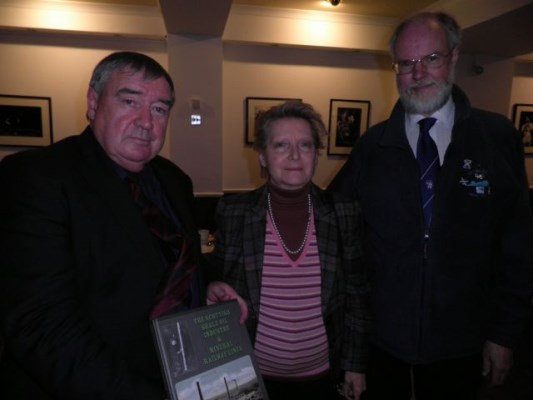
4th October: Harry Knox on West Lothian shale-oil
No-one brought up in West Lothian could ignore shale-oil which was what made the area unique : for while other Scottish industrial areas had coal - and indeed the Lanarkshire coalfield stretched into its eastern neighbour - none had anything like the oil-bearing strata that stretched three miles wide for the twenty-five miles from Cobbinshaw to Burntisland. Shale is a compressed laminated carboniferous clay laid down in water 360 million years ago from the leaves of forests that bordered a tropical lake at a time when Scotland was close to the equator.In 1851 Dr James Young who had seen the potential for breaking down into useful materials the tarry deposits in Derbyshire coal mines opened the world's first oil refinery at Bathgate using local canneloid coal. A quarter of London's paraffin oil was produced there, but the canal-coal was running out so he decided to concentrate on shale production burning coal brought in from elsewhere and in 1861 opened a new refinery at Addiewell which became the largest in the world. At one time as many as 120 companies were active, but they soon consolidated as the Americans got in on the act - but only in Scotland was it possible to produce also sulphate of ammonia for use as a fertiliser. The seven surviving companies merged in 1921 to form Scottish Oils centred on the refinery at Pumpherston.Most of the fifteen seams in West Lothian are shallow, but a syncline at West Calder requires digging deeper. Miners had to buy their own explosives and to pay workers called drawers to bring their output to the surface. Extraction was either by long-wall digging of working in parallel or else by "stoop and room" with piles of phosphorus that were then pulled in to create subsidence. Crude oil was placed in retorts for condensation, and the Pumpherston Retort became the standard design overseas. Sulphuric acid purified crude into green oil, taking off ammonia, naphtha and paraffin wax which was sold until Scottish Oils realised the merit of making their own candles in a purpose-built factory at Addiewell. A second process allowed the oil to be broken down under pressure into its various strengths, and was the origin of cracking.
An influx of Irish workers brought social problems, transforming Bathgate which had been a weaving town and West Calder which had been an agricultural centre. Oil companies built new villages at Oakbank, Philpstoun, Pumpherston and Dalmeny, but roads were unsurfaced and the
housing was often very poor, with standpipes in the streets as there was no running water. One such place near Addiewell was known as the Happy Land since with its earthen floors it seemed anything but, however one former resident insisted that it had been the best place in the world and his young life was spoiled when he had to move from there into a Council house, and miners' houses have survived even in the area of what became Livingston New Town.
The least popular job was tipping hutches of spent shale onto the bing, but the wartime introduction of coalcutters eased working conditions underground shale mining was less unhealthy than coal because it was classed as gas-free with canaries on hand to test if there was any doubt.
Dr Young who was the local GP declared that it was the fumes from the oilworks that kept the Addiewell bairns free from scarlet fever and diphtheria. The very full social life of shale-mining communities included whippets and pigeons, flower-shows, village galas, pipe bands, amateur dramatic groups and sports such as quoits and curling.
The remotest community at Tarbrax nine hundred feet above sea-level was served by its own branch of the West Calder co-op, and managed to have its own gala. Winchburgh had the Niddry Castle oilworks whose site is now a golf-course, and Broxburn's works were by the Union Canal but came too late to revive its fortunes. At Pumpherston refinery, detergent first developed in 1947 became marketed as biprox and continued in production until 1993 to disperse North Sea oil spills. Westwood was the last works, developed in a new mood of confidence during the Second World War by Scottish Oils and contributing to the bing now known as the Five Sisters. A German-built ropeway linked Oakbank with Pumpherston because of the intervening ravines, and a 2'6"-gauge electric railway taking shale to the works at Winchburgh also conveyed miners. Pug engines shunted sidings into most works from the mainline network.
The end for shale oil came quickly when in 1962 the Government removed its tax concessions, ordering the British Motor Corporation to relocate a new truck plant to Bathgate where it turned out to be too far from the industry's heartland in the English Midlands. The distinctive landscape
faded as material from bings soon proved attractive in the construction of new motorways, but most of the shale is still there under the ground and the current debate about fracking may rekindle interest in its exploitation.